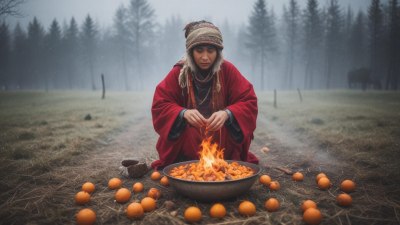How Different Cultures Celebrate Changing Weather with Food and Rituals
Explore global traditions that celebrate seasonal changes with unique foods and rituals, from spring festivals to harvest feasts.

This image was created with the assistance of Freepik
The changing weather throughout the year has inspired various cultures across the globe to celebrate with distinct foods and rituals. These celebrations often signify the transition from one season to another, marking important agricultural milestones, spiritual beliefs, and communal gatherings. As the days lengthen and the temperatures rise in spring, communities refresh their spirits with vibrant festivals, welcoming new life and growth. Summer, with its bounty of ripe fruits and vegetables, brings about gatherings focused on gratitude for the harvest and preparation for the impending autumn. Autumn itself is a time for reflection, as communities honor their harvests, giving thanks for the abundance of the season while preparing for the colder months ahead. Finally, winter often invokes introspection and family gatherings, where different cultures celebrate the resilience of life during the toughest weather. Each season's transition is marked not only by changes in the environment but also by a rich tapestry of culinary delights and ceremonies.
Spring Celebrations: Welcoming New Life
In many cultures, spring is synonymous with renewal and rebirth. One of the most famous spring celebrations is Easter, celebrated in various ways around the world. In countries like Italy and Poland, families prepare traditional dishes such as Easter lamb or a variety of cakes that symbolize resurrection and new life. In Japan, hanami celebrates the blooming of sakura (cherry blossoms). People gather for picnics under the trees, enjoying seasonal delicacies like sakura mochi, a sweet rice cake filled with red bean paste and wrapped in cherry leaves. This practice emphasizes the beauty of nature and the fleeting nature of life.
In India, the festival of Holi marks the arrival of spring with joyous celebrations filled with color, music, and dance. Traditional dishes, such as gujiya (sweet dumplings) and various savory snacks, are shared among friends and family. The use of vibrant colored powders and water during the festival symbolizes the triumph of good over evil and the joy of life’s renewal. Similarly, in Iran, the festival of Nowruz, the Persian New Year, celebrates the vernal equinox with festive meals featuring dishes like sabzi polo (herbed rice) and fish, symbolizing fertility and growth.
Summer Festivals: A Bounty of Flavors
As the weather warms up and yields an abundance of fresh produce, many cultures celebrate summer with vibrant festivals that showcase the season’s bounty. The Mediterranean region is famous for its summer tavernas, where locals gather to enjoy fresh seafood, grilled vegetables, and an array of colorful salads. The annual Tomatina festival in Spain is a quirky example of celebrating the tomato's abundance, where participants engage in a playful food fight, symbolizing the joy and abundance of the harvest season.
In the United States, the Fourth of July not only celebrates Independence Day but also serves as an occasion for barbecues and picnics, featuring traditional foods like hot dogs, hamburgers, and corn on the cob. Communities gather for fireworks displays, and the camaraderie resonates with gratitude for the seasonal bounty and the celebration of freedom. In Southeast Asia, the Thai festival of Songkran, marking the traditional New Year in April, involves water festivities and the preparation of special dishes like khao chae (rice soaked in jasmine-scented water) to signify cleansing and rebirth in the hot summer months.
Autumn Harvest: Gratitude and Reflection
Upon entering autumn, many cultures turn their focus toward giving thanks for the harvest. Thanksgiving in the United States is a quintessential example, where families gather to share a feast centered around turkey, stuffing, cranberry sauce, and pumpkin pie—each dish symbolizing the autumn harvest. This celebration highlights the importance of unity and gratitude for the food shared among loved ones.
In many Asian cultures, the Mid-Autumn Festival celebrates the harvest moon with mooncakes, a traditional pastry filled with sweet or savory fillings. Families often gather to admire the full moon and express gratitude for the harvest. The festival encapsulates a sense of reunion, as families come together to celebrate the bonds forged by shared meals and the abundance nature provides.
In Mexico, Día de los Muertos (Day of the Dead), celebrated at the end of October, combines the honoring of deceased ancestors with autumnal foods. Families create altars adorned with offerings such as pan de muerto (bread of the dead) and sugar skulls, blending the themes of life, death, and the cyclical nature of seasons and harvests.
Winter Traditions: Community and Resilience
The winter months often symbolize a time of reflection, warmth, and togetherness in many cultures. Christmas traditions across Western cultures prominently feature festive foods such as roast dinners, gingerbread cookies, and eggnog, emphasizing family gatherings and the spirit of giving. The warmth of these gatherings counteracts the cold weather, celebrating the bonds of love and community.
In Scandinavia, the winter solstice is celebrated with the Feast of Yule, where families share hearty meals featuring roasted meats, root vegetables, and baked goods. This celebration not only honors the return of the light after the longest night of the year but also connects families with ancient traditions that highlight resilience in the face of harsh conditions.
Asian cultures also have their own winter celebrations. For example, the Lunar New Year, celebrated in countries like China and Vietnam, features a lavish family reunion feast with symbolic foods such as dumplings and fish, symbolizing prosperity and unity. Additionally, in Japan, New Year celebrations include traditional dishes like osechi-ryori, a bento-style meal comprising assorted foods, each with a special meaning signifying health, longevity, and prosperity for the coming year. These winter celebrations reflect resilience and hope during the cold months, reinforcing family ties and cultural heritage.
The Global Symphony of Seasonal Celebrations
Across the planet, different cultures showcase a unique intersection of weather changes, foods, and rituals, creating a rich tapestry of seasonal celebrations. Each tradition carries its own historical significance, tying together communities with a common thread of gratitude, resilience, and joy. As we partake in these celebrations, we not only honor our cultural heritage but also acknowledge the profound relationship between humanity and nature's seasonal cycles. The act of gathering around a table filled with traditional foods during these festivals serves as a reminder of the abundance the earth offers and the importance of coming together as a community. In a world that is constantly changing, these rituals keep us grounded and remind us of the beauty in the cycles of life, in all their flavors and colors.











